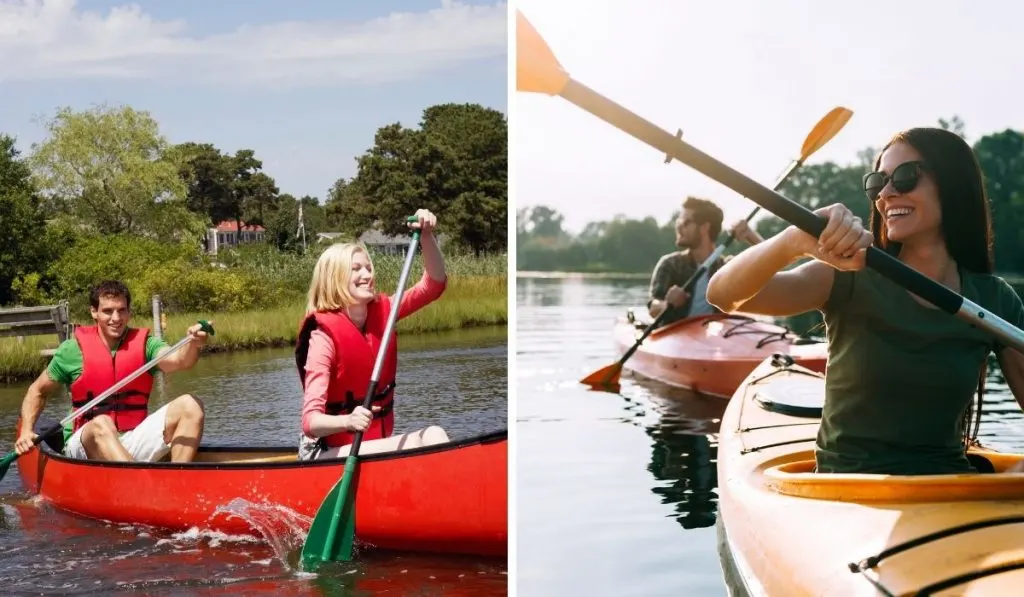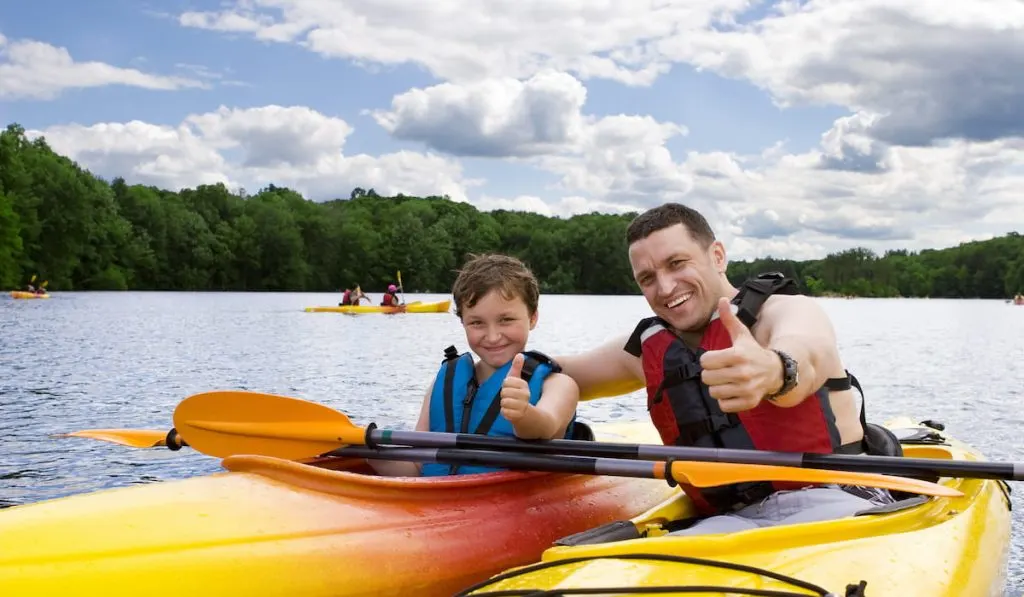If you grew up going to camps outdoors, then you probably remember getting out on the water in a canoe.
Most of the time, beginner canoers start by launching from and paddling on calm waters on lakes where there is relatively little risk. It’s easy to bail if you have to and return to shore.
Now you’re an adult, though, and you’re thinking about getting back out there when the weather turns nice again.
Do you go for the nostalgia of the canoe or with something like a kayak because you see so many of them these days? What’s better for beginners?
Most people choose kayaks because they’re usually lighter and smaller than canoes. They can fit easily on top of suburban SUVs for a quick weekend trip to the river or lake in the area.
However, a canoe’s size typically makes it more comfortable and easier to move around because you’re sitting higher up on the water.

They’re also amazing for people who want to paddle in tandem with kids, a partner, or a friend.
Let’s take a look at some of the main differences between canoes and kayaks to help you decide what’s best. At the end of the day, whatever gets you out on the water and having fun will be a great choice!
Design Differences Between Kayaks and Canoes
Canoes are almost always a lot bigger and heavier than kayaks. You virtually always need more than one person to move them any amount of distance, and that is doubly true for when you need to load or unload them for trips.
Canoes are bigger, though, because they’re designed to carry multiple people. On your standard canoe, you can usually fit a paddler in the back, one in the front, and a couple of people or kids in the middle. They’re great for a family day on the lake.
Kayaks, on the other hand, are built with portability and convenience in mind. Sure, there are some kayaks made for getting down white water rapids quickly, but that’s not the typical kayak any beginner will be looking at.
For the most part, they want something that they can pick up by themselves, toss on the car or in the truck, and head out for the weekend.
Canoes are also open-top, meaning there is no cover and you can move in and out of them with ease. Kayaks usually come with closed cockpits. Kayakers insert their legs into the boat and their torso is the only part of their body exposed.
There are now, however, more and more open kayaks that are also called “sit on top” kayaks where you simply sit on them and paddle like you would with a traditional kayak.

Comfort & Ease of Use
As with most things in life, whether you like kayaks or canoes often comes down to personal preference. One thing to consider before buying is how you’ll use it and where you’ll want to feel comfortable while you’re out on the water.
Canoes offer more freedom of movement inside the boat itself. They have wider bodies, and your legs are set in grooves or trapped inside a cockpit. Some people like being able to walk inside their canoe and change positions in the middle of the lake, or to reach for the cooler to grab a drink when it’s a few feet away.
Other folks like feeling snug and secure in smaller kayaks where they generally have more control over how they move and react to weather conditions.
But what about getting around? Is there a difference in ease of use between a kayak and a canoe?
Kayaks and canoes have very different learning curves.
Kayaks are easier to paddle because they are lower in the water, narrower, and lighter. If you’re an inexperienced paddler, then a kayak will be a lot easier to learn in. You’ll discover quickly how small paddle movements affect your trajectory and your speed.
Canoes, however, are harder to paddle because you’re switching sides and steering a heavier vessel. You also have a partner you must rely on to paddle in sync and move smoothly through the water. Something to consider when you’re deciding between the two.

Fishing on a Kayak vs. Fishing on a Canoe
Getting out on the water for a bit of exercise is fun, but eventually, you’re going to want to use your canoe or your kayak for more. One thing people love to do is use their kayak or canoe for fishing. But is one better than the other? Again, that depends.
If you’re someone who likes to spend a lot of time on the water, or you want to bring a friend, then a canoe is probably your best bet. The larger space and open design make it easy to bring things to eat and prepare for lunch, and you can bring larger tackle boxes, more rods, and make adjustments easier on the fly.
You’ll be glad you bought a canoe if you’re always trying to undo knots in your kids’ fishing lines.
But if you’re the kind of person who doesn’t need a lot of gear to fish, then the convenience of a kayak will suit you just fine. You can stash a rod and a few other items with bungee cords, and toss in whenever you see a good spot or feel like it.
Final Thoughts
The bottom line is that canoes are usually more for people who are into leisure activities with the family or with friends. You’re not taking down any rapids in a big, heavy canoe, but a day on the lake with sandwiches and songs playing on the radio is your kind of day.
If you like a bit more adventure, something lightweight, and portable, then kayaks are a great choice for beginners. As you gain experience and level up on your kayak, you can start exploring trickier waters in your area and push your kayak and yourself further.
Both are great ways to get outside and enjoy nature. Get out there and have some fun!
